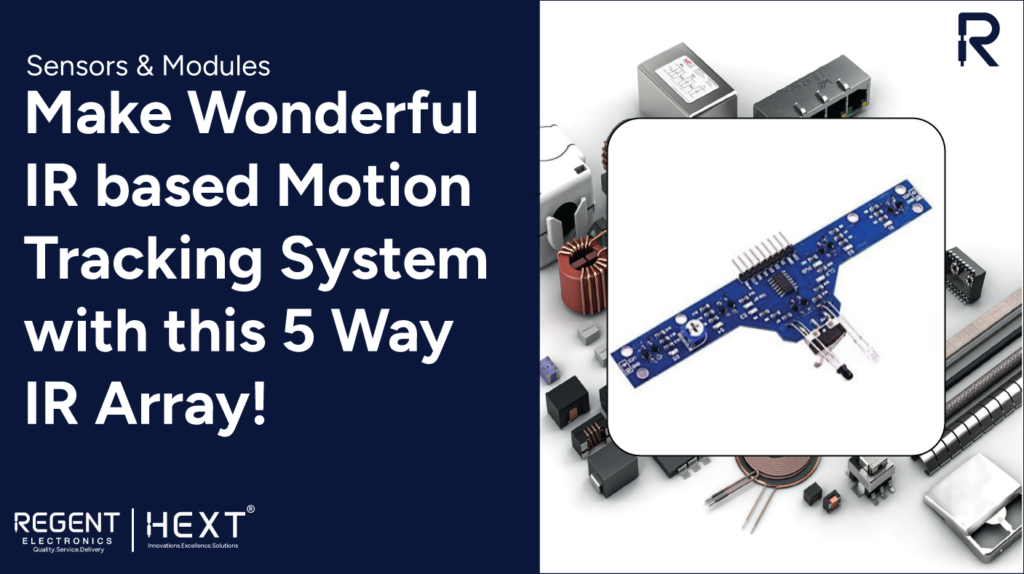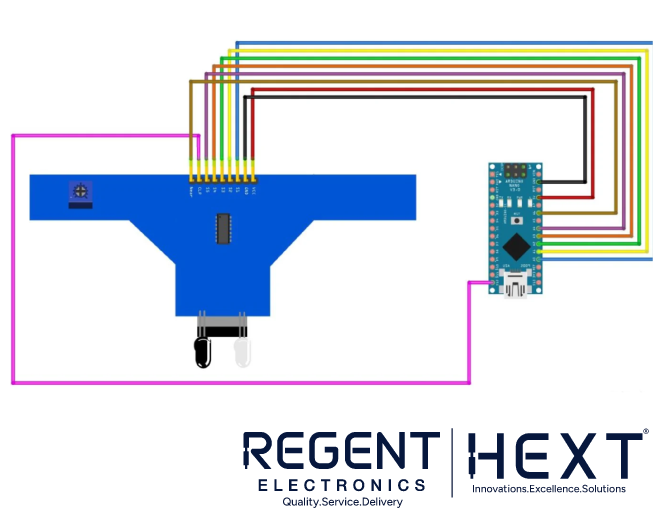
Create an IR-Based Motion Tracking System with the 5-Way IR Array: Revolutionize Your Projects!
Infrared (IR) sensors are vital in detecting motion and measuring infrared radiation from objects. These sensors are commonly used in various applications, such as motion sensing for alarms or tracking systems. Objects emitting heat above absolute zero radiate infrared energy, which is invisible to the human eye but detectable by IR sensors. These sensors can output changes in infrared radiation as voltage, which can be processed by microcontrollers like Arduino.
In this article, we explore how to build a 5-Way IR Motion Tracking System using an IR sensor array. This setup includes 5 TCRT IR sensors, an IR sensor for obstacle detection, and a limit switch to enhance functionality. This system is ideal for robotics, automation projects, and other applications requiring motion detection and tracking.

What is the 5-Way IR Array?
The 5-Way IR Array is an integrated sensor module designed for tracking and obstacle detection. It includes 5 TCRT sensors that detect infrared light, an IR sensor placed at the front for obstacle detection, and a limit switch to provide feedback when triggered. The module is designed for easy integration into robotics and motion-tracking systems.
Key Features of the 5-Way IR Array:
- 5 TCRT IR Sensors: Detect changes in infrared light across multiple channels for precise motion tracking.
- Obstacle Detection: The front-facing IR sensor helps in detecting obstacles in your path.
- Limit Switch: The limit switch provides high voltage when pressed, helping track specific positions or trigger actions.
- Adjustable Sensitivity: The built-in potentiometer allows you to fine-tune the sensor sensitivity for better performance in various environments.
- Easy Integration: Compatible with microcontrollers like Arduino, making it simple to integrate into your projects.
How to Use the 5-Way IR Array Module?
The 5-Way IR Array module comes with 9 pins, including 5 output pins for the TCRT sensors, 1 output pin for the IR sensor, and 1 pin for the limit switch. Below are the simple connection steps for integrating the module with an Arduino:
Connections:
- Connect the VCC pin of the module to the 5V pin of the Arduino.
- Connect the GND pin of the Arduino to the GND pin of the module.
- Connect the S1 pin of the module to A0 on the Arduino.
- Connect the S2 pin of the module to A1 on the Arduino.
- Connect the S3 pin of the module to A2 on the Arduino.
- Connect the S4 pin of the module to A3 on the Arduino.
- Connect the S5 pin of the module to A4 on the Arduino.
- Connect the CLP pin of the module to digital pin 12 on the Arduino (for limit switch).
- Connect the Near pin of the module to A6 on the Arduino (for front-facing IR sensor).
Once the connections are made, use the potentiometer on the module to adjust the sensitivity based on your application requirements. This sensor array performs best when there is a high contrast between the surfaces being detected, which allows both the TCRT sensors and the IR sensor to function optimally.
Sample Code for Arduino:

cpp
CopyEdit
int s1 = A0; // TCRT1
int s2 = A1; // TCRT2
int s3 = A2; // TCRT3
int s4 = A3; // TCRT4
int s5 = A4; // TCRT5
int near = A6; // IR sensor to detect obstacles
int CLP = 12; // Limit switch
int state1, state2, state3, state4, state5, nearstate, CLPstate;
void setup() {
Serial.begin(9600);
pinMode(s1, INPUT);
pinMode(s2, INPUT);
pinMode(s3, INPUT);
pinMode(s4, INPUT);
pinMode(s5, INPUT);
pinMode(near, INPUT);
pinMode(CLP, INPUT);
}
void loop() {
state1 = digitalRead(s1); // TCRT1 status
state2 = digitalRead(s2); // TCRT2 status
state3 = digitalRead(s3); // TCRT3 status
state4 = digitalRead(s4); // TCRT4 status
state5 = digitalRead(s5); // TCRT5 status
nearstate = analogRead(near); // IR sensor status
CLPstate = digitalRead(CLP); // Limit switch status
Serial.print(“s1 = “);
Serial.println(state1); // Print TCRT1 status
Serial.print(“s2 = “);
Serial.println(state2); // Print TCRT2 status
Serial.print(“s3 = “);
Serial.println(state3); // Print TCRT3 status
Serial.print(“s4 = “);
Serial.println(state4); // Print TCRT4 status
Serial.print(“s5 = “);
Serial.println(state5); // Print TCRT5 status
Serial.print(“IR = “);
Serial.println(nearstate); // Print IR sensor status
Serial.print(“BMP = “);
Serial.println(CLPstate); // Print Limit switch status
delay(100);
}
Once the code is uploaded to your Arduino, you’ll be able to view the real-time sensor data through the serial monitor, allowing you to track the status of each sensor and adjust accordingly.
Applications of the 5-Way IR Array:
- Line Follower Robots: Detect and follow paths based on the contrast between surfaces.
- Shaft Encoders: Track the rotation of mechanical parts for precise control in automation systems.
- Obstacle Avoiding Robots: Automatically navigate and avoid obstacles using the IR sensor array.
- Warehouse Robots: Optimize movement and placement in automated warehouses by detecting and avoiding obstacles.
Get Your 5-Way IR Array at Regent Electronics!
At Regent Electronics, we offer high-quality electronic components like the 5-Way IR Array to help bring your innovative projects to life. Whether you’re building a robotics system, designing a motion-tracking device, or creating an obstacle-avoiding robot, this sensor array is the perfect solution.
Shop the 5-Way IR Array today at Regent Electronics and take your DIY projects to the next level!
Upgrade Your Projects with Regent Electronics!
Explore our vast selection of sensors, modules, and other electronics components to enhance your next project. Regent Electronics is your trusted source for high-quality, reliable parts and excellent customer service. Visit Regent Electronics to learn more and shop now!
